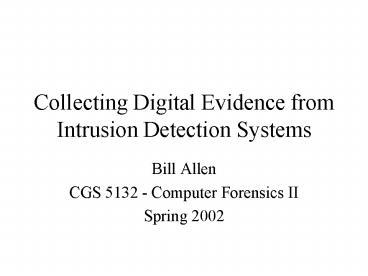Collecting Digital Evidence from Intrusion Detection Systems - PowerPoint PPT Presentation
1 / 9
Title:
Collecting Digital Evidence from Intrusion Detection Systems
Description:
he used a phone hop through Bogota to a Seattle ISP ... no logs from Bogota, couldn't link Pryce to ISP. Pryce's phone logs only showed time of calls ... – PowerPoint PPT presentation
Number of Views:128
Avg rating:3.0/5.0
Title: Collecting Digital Evidence from Intrusion Detection Systems
1
Collecting Digital Evidence from Intrusion
Detection Systems
- Bill Allen
- CGS 5132 - Computer Forensics II
- Spring 2002
2
Intrusion Detection Systems are not designed for
forensic use
- opposing design goals - speed vs. accuracy
- high false-alarm rate - accuracy is not proven,
will it be admissible? - reliability not proven - evaluations show that
packets are often dropped in high traffic periods - insecure logging of alerts/data - chain of
custody may not be maintained - usually runs unattended - who can access it?
- can be attacked - susceptible to denial of
service
3
What is needed?
- reliability - no dropped packets or lost files
- reducibility - need tools to filter out
everything but the real evidence - secure storage of evidence - need the digital
equivalent of an evidence locker - access controls for operators / investigators -
access to hardware, software and data must be
controlled and automatically logged to prevent
tampering or a break in the chain of evidence
4
The IDS Logs are the Key!
- must include sufficient detail to identify
date/time, type of intrusion, possible sources,
etc. - must be stored in a safe place, not on a machine
that can be compromised - must be protected from being compromised before,
during and after the intrusion - must accurately report all evidence of the
intrusion - must be coordinated to show all of the actions
taken by the intruder, system-wide
5
Case Study Rome AFB 1994
- intruder detected by IDS at Rome, NY AFB
- individual named Richard Pryce was identified and
arrested by Scotland Yard in England - AF must prove that Pryce was the intruder
- he used a phone hop through Bogota to a Seattle
ISP - he hacked several machines at Rome and downloaded
classified data - his home computer and phone records were seized
- logs at Seattle ISP and from Rome IDS were
available
6
What went right
- Pryce was identified because he bragged to an
undercover AF intelligence officer in a chat room
- Pryces computer contained stolen classified data
- Pryces phone records showed that his calls
matched the time of intrusion - Seattle ISP logs showed Pryces hacking
activities - Investigators and prosecutors presented enough
evidence that Pryce plea bargained soon after the
trial began and before a ruling was made
7
What could have gone wrong
- the defense was not allowed access to much of the
forensic data because it was classified - no logs from Bogota, couldnt link Pryce to ISP
- Pryces phone logs only showed time of calls
- there was no proof of a direct connection between
Pryce and the intruder at Rome AFB - because a large team was involved in the case,
the presenter of evidence in court was not one of
the forensic investigators
8
Suggestions
- IDS should be used to indicate possible
intrusions - gathering / investigating forensic evidence
should be a separate operation - must be able to coordinate multiple sources with
time / data synchronization - evidence logs should be cryptographically secure
- access to data, hardware and software must be
controlled and logged
9
References
- Peter Sommer, Intrusion detection systems as
evidence, Computer Networks 31, 1999 - Peter Stephenson, The Application of Intrusion
Detection Systems in a Forensic Environment,
proceedings of RAID 2000 - Patrick Mueller, Dragon Claws its Way to the Top,
Network Computing, Aug 2001 - Bruce Schneier and John Kelsey, Secure Audit Logs
to Support Computer Forensics, ACM Trans. on
Information and Computer Security, May 1999































